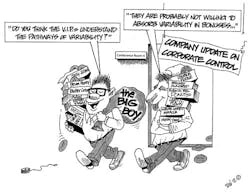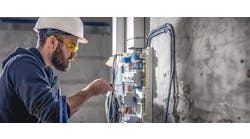Check out ControlGlobal.com on Google+
Greg: Now that we have a good control valve, courtesy of last month's column with James Beall, let's move on to tuning the controller.James comes from a culture of internal model control favored at Eastman as the result of ties to the University of Tennessee. He became a consultant with Emerson in a group formed by the acquisition of EnTech Control, where Lambda tuning, like IMC tuning, "quantifies the tuning response" by its setpoint response and a corresponding, well-defined load regulation response. Lambda is a closed-loop time constant for self-regulating processes and an arrest time for integrating processes.
I am a product of Shinskey's approach of maximizing disturbance rejection, and the transfer of variability from the process variable to the manipulated variable, except for isolated cases, such as surge tank level control.
Stan: Before software for tuning became prevalent, plants often used a trial-and-error method. I principally have seen reset times too small because of human impatience. Besides the obvious problem of inconsistent and poor results from human limitations in understanding the future effects of tuning settings, what are some of the other downsides of the ad-hoc approach?
James: By having sound loop-tuning methodology, you can detect if something has changed in the process rather than just re-tuning the loop over and over. For example, I was asked to retune a temperature loop for a polypropylene reactor. Even though the process operating conditions had not changed, I spent the time to re-test the process response. The process analysis software showed that the process model was significantly different that when I previously tested it. However, since the process was at the same conditions as before, and I had confidence in my process analysis system, I questioned the operating personnel about what might be different. They did some investigation and found that there was a ppm level of moisture in the reactor catalyst, which severely changed the reaction rate. They replaced the catalyst and the process preformed as desired using the tuning that I had initially installed! A year later I got a call to retune the same loop. Before I spent the time to re-test the process, I asked them to check the catalyst for moisture. Sure enough, they found the same problem had reoccurred. They replaced the catalyst, I stayed on the lake fishing, and we both were happy!
Stan: There is a lesson here that tuning should not be used to cover up field problems. You can make almost any problem seem less by detuning the PID to the point there is no response by the controller as noted by Michel Ruel in the November 2012 Control Talk, "Ruel Rules for the Use of PID, FLC and MPC" What should our focus be?
James: Tuning should help the PID do the real job of the loop; that is, to increase process efficiency and production. Sometimes there is a need to coordinate loops and sometimes to absorb variability. Though the "closed-loop setpoint response" is used as the "response knob" for Lambda tuning, the load regulation response is also very important and very well-defined for Lambda tuning. In the presence of dead time (an enemy of loop performance!), all tuning can amplify variability in the process. In other words, the PID controller can actually increase variability! And the more aggressive the tuning is, the higher the variability amplification will be. We use Lambda tuning techniques to intelligently attenuate variability or transfer it to the least detrimental point in the process.
Greg: Alternately, you can retain disturbance rejection tuning, enable the external-reset option, and use a AO or PID setpoint filter or rate limit to slow down the transfer of variability as described in the Nov. 28, 2012, Control Talk blog, "Is It Better to Have a Controller with More or Less Knobs." Rate limits provide the move suppression (penalty on move) found to be so important in model-predictive control.
James: The most frequently poorly tuned loop is a level loop with severe consequences of initiating a variability that pervades a whole train of equipment. Level loops most often have an "integrating" response, and good tuning methods for these processes don't seem to be taught and used as commonly as for self-regulating processes. A 10,000-gal surge tank level loop not tuned to absorb variability can make that tank effectively a mere 100-gal tank in terms of its ability to absorb variability! These loops need a gain setting that will only react enough to keep the level within tank alarm limits for the expected load change. The computation of Lambda equal to twice the allowable error divided by the product of the integrating process gain and maximum change in controller output required will effectively maximize the absorption of flow variability into the surge tank. The integrating process gain is inversely proportional to residence time of the portion of the vessel measured by the level transmitter. The Lambda tuning rule makes sure the reset time is large enough to avoid any tendency to oscillate (i.e., critically damped) for the PID gain setting.
Stan: Where have you used this method beside surge tanks?
James: I used the same calculation for a large distillate receiver where the level controller manipulates distillate flow to take full advantage of the receiver size to smooth out the flow to downstream operations. Surprisingly, it can be beneficial for the level controller on the base of a distillation column where it manipulates the bottoms flow that feeds the next column. Ironically, you can also use the same equation, with a small "allowable error," to provide "tight," yet not oscillatory control of an integrating process such as a reactor level.
Greg: If a temperature controller was manipulating distillate flow, and the receiver level controller was manipulating reflux flow, very tight level control would be needed because the effect of temperature control actions do not get into the column until the level controller makes the corresponding correction in reflux flow. Other cases where you need tight level control are recycle tank material balance control and continuous liquid reactor residence time control.
James: These are great examples to think about variability pathways and maximizing process performance! In the case of the distillation example, feed-forward (with a negative 1 lb/lb gain) from the distillate flow to reflux flow (via the level controller) and a Lambda to provide maximum absorption of variability provides an immediate correction in the reflux flow without passing the variability of the condensing system and receiver level into the column.
Greg: I agree, feed-forward control offers a significant advantage. We normally extend feed-forward control to account for feed flow changes by ratioing the distillate flow to the feed flow. Feed-forward summers provide correction of the distillate flow by the temperature controller and reflux flow by the level controller. Tight temperature and level control correct for flow measurement errors and unknowns. Tight level control offers an additional advantage of helping provide internal reflux control. For example, a cold rainstorm can be a sudden severe upset that reduces the column vapor traffic and condensing rate even though the feed rate is constant. Tight level control will reduce the reflux to the column, helping to maintain the internal reflux to vapor ratio inside the column. Temperature correction of the distillate flow is late because of the significant dead time in the composition response. If there are operating or control problems with the condensing system, these need to be fixed. Measurements should have a high threshold sensitivity and minimal noise for tight control. A resistance temperature detector (RTD) and guided wave radar (GWR) offer this capability.
Top Ten Signs Your Loop Tuning Is a Mess
(10) Tuning software is nonexistent.
(9) Lots of trials and errors.
(8) Don't know if the proportional setting is PB or gain.
(7) Units of reset setting are unknown.
(6) Lambda is zero.
(5) Trend charts look like a tempest.
(4) Valves are worn out.
(3) Tempers are worn thin.
(2) Low and high output limits are set equal.
(1) Preferred mode is manual.







